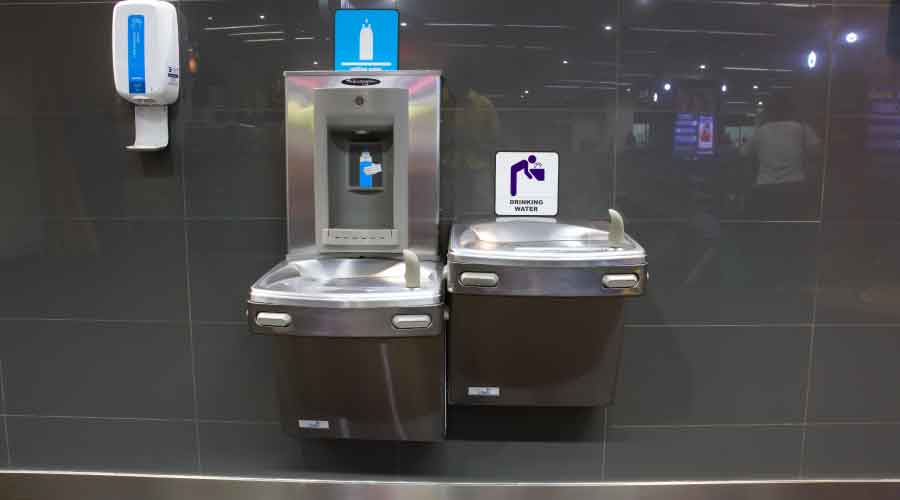How to Focus on Water Quality in Facilities
The WELL Standard offers specific strategies and targets to ensure the highest water quality in buildings.
By Greg Zimmerman, Senior Contributing Editor
Beyond energy efficiency and occupant satisfaction, facility managers have just one, huge, overarching goal: That their facilities stay out of the headlines. Whenever there’s a facility-related problem that crosses over to mainstream news, facility managers can be assured they’ll take the brunt of the blame. That's not great for career advancement.
Poor water quality that includes legionella is one example of this happening. If occupants are sick or even die with Legionnaires disease, not only is it a horrific tragedy that could’ve been avoided, facility managers may also open themselves and their organizations up to liability.
The recent issues with water quality in Flint, Michigan, and Jackson, Mississippi, though not individual-building related, are also examples of how poor water quality can be a huge detriment to the health and wellbeing of an entire community. The problems with water in these two cities should definitely be wake-up calls for facility managers to establish stringent water quality standards and water quality management plans in their own buildings.
Facility managers need to do everything in their power to measure and monitor water quality, and ensure that not only it’s free of pathogens like legionella, but also that water quality in a facility is enhancing and protecting the health and wellness of facility occupants and visitors.
This was especially challenging during the pandemic as buildings stood empty, and faucets, drinking fountains, and other water-using fixtures weren’t being used. Legionella became a real risk, and it was incumbent upon facility managers to do water quality testing and monitoring to ensure the safety of their water.
As the pandemic wanes, the importance of water quality doesn’t. The WELL Standard – a comprehensive whole-building rating system for health and wellness – is one of the best resources facility managers can use to ensure good water quality in their buildings. The WELL standard “promotes safe and clean water through the implementation of proper filtration techniques and regular testing in order for building occupants to receive optimal quality of water for various uses.”
How does it do that? And how can facility managers use WELL as a resource for their facilities?
WELL and water quality
The WELL Standard offers eight “features,” or individual strategies, focused on water quality. Each feature defines the issue it sets out to address with a background statement, and then gives users a simple guide to strategies.
The first, and arguably most important feature in the WELL Standard for water quality, is simply titled “Fundamental water quality.” This feature defines two properties of water that can tell facility managers their water may be problematic: Turbidity and total coliforms.
Turbidity is the measure of how clear a liquid is. “High turbidity can provide food and shelter for germs,” according to WELL. If a facility has high turbidity, i.e., cloudy water, the first step is to check the building’s water filtration to ensure it’s working properly. The WELL standard for turbidity in drinking water is 1.0 NTU (nephelometric turbidity units) measured with an electronic handheld meter specifically designed to measure turbidity.
Coliform bacteria itself is generally harmless, but it is known as an “indicator organism” – that is, its presence can be a proxy for detecting other harmful bacteria, viruses, or protozoa. Water in a building should have zero coliform bacteria detected with a standard test, according to WELL.
WELL also includes four features to test and identify specific substances in water, including inorganic contaminants, organic contaminants, agricultural contaminants, and public water additives. WELL has specific standards for the amounts of these substances – for instance, in the inorganic feature, the standard says water must contain less than 0.01 mg/L of lead, and in the organic feature, water must contain less than 0.001 mg/L of benzene.
Another WELL feature has requirements for periodic water quality testing and another is a standard for water treatment. A final water quality feature is about drinking water promotion with standards for tap water taste and suggestions to make sure building occupants drink plenty of water throughout their day to stay hydrated, and thus, healthier. “Improving the taste and appearance of tap water encourages increased water consumption and reduces reliance on bottled water,” says the feature.
These eight water quality features in WELL are part of the much larger, whole-building health and wellness picture the WELL Standard attempts to create. For facility managers looking specifically to focus on water quality in their facilities, these eight strategies represent an excellent list of best practices to get started.
Greg Zimmerman is senior contributor editor for the facility group, which including FacilitiesNet.com and Building Operating Management magazine. He has more than 19 years’ experience writing about facility issues.
Related Topics:












